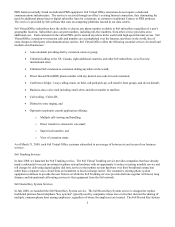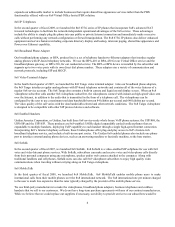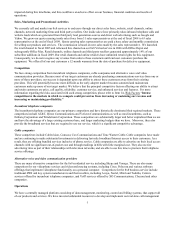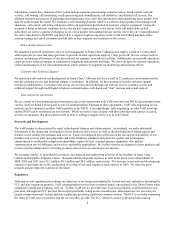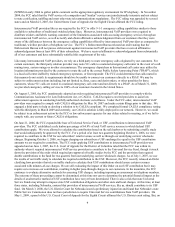8x8 2009 Annual Report Download - page 17
Download and view the complete annual report
Please find page 17 of the 2009 8x8 annual report below. You can navigate through the pages in the report by either clicking on the pages listed below, or by using the keyword search tool below to find specific information within the annual report.15
services that provide increasingly higher levels of performance and reliability at lower cost. These new and enhanced products
must take advantage of technological advancements and changes and respond to new customer requirements. Our success in
designing, developing, manufacturing, and selling such products and services will depend on a variety of factors, including:
• quality of the service that we provide;
• the identification of new technologies and timely implementation of product design and development;
• the scalability of our VoIP telephony software products;
• product and feature selection;
• product performance;
• cost-effectiveness of current products and services and products under development;
• our ability to successfully implement service features mandated by federal and state law; and
• effectiveness of promotional efforts.
Decreasing telecommunications rates and increasing regulatory charges may diminish or eliminate our competitive
pricing advantage.
Decreasing telecommunications rates may diminish or eliminate the competitive pricing advantage of our services. Increased
regulation and the imposition of additional regulatory funding obligations at the federal, state and local level could require us to
either increase the retail price for our services, thus making us less competitive, or absorb such costs, thus decreasing our profit
margins. In fiscal 2007, we began to pass Universal Service and E-911 fees and taxes onto our customers and in fiscal 2008
and 2009, we began to pass sales, use and communications taxes onto certain of our customers. International and domestic
telecommunications rates have decreased significantly over the last few years in most of the markets in which we operate, and
we anticipate these rates will continue to decline in all of the markets in which we do business or expect to do business. Users
who select our services to take advantage of the current pricing differential between traditional telecommunications rates and
our rates may switch to traditional telecommunications carriers if such pricing differentials diminish or disappear, and we will
be unable to use such pricing differentials to attract new customers in the future. In addition, our ability to market our services
to other service providers depends upon the existence of spreads between the rates offered by us and the rates offered by
traditional telecommunications carriers, as well as a spread between the retail and wholesale rates charged by the carriers from
whom we obtain wholesale services. Continued rate decreases would require us to lower our rates to remain competitive and
would reduce or possibly eliminate any gross profit from our services. Furthermore, if telecommunications rates continue to
decline, we may lose subscribers for our services.
We rely on third party network service providers to originate and terminate substantially all of our public switched
telephone network calls.
We leverage the infrastructure of third party network service providers to provide telephone numbers, PSTN call termination
and origination services and local number portability for our customers rather than deploying our own network throughout the
United States. This decision has resulted in lower operating costs for our business in the short term but has reduced our
operating flexibility and ability to make timely service changes. If any of these network service providers cease operations or
otherwise terminate the services that we depend on, the delay in switching our technology to another network service provider,
if available, and qualifying this new service could have a material adverse effect on our business, financial condition or
operating results.
While we believe that relations with our current service providers are good and we have contracts in place, there can be no
assurance that these service providers will be able or willing to supply cost-effective services to us in the future or that we will
be successful in signing up alternative or additional providers. While we believe that we could replace our current providers, if
necessary, our ability to provide service to our subscribers would be impacted during this timeframe, and this could have an
adverse effect on our business, financial condition or results of operations. The loss of access to, or requirement to change, the
telephone numbers we provide to our customers also could have a material adverse effect on our business, financial condition
or operating results.


